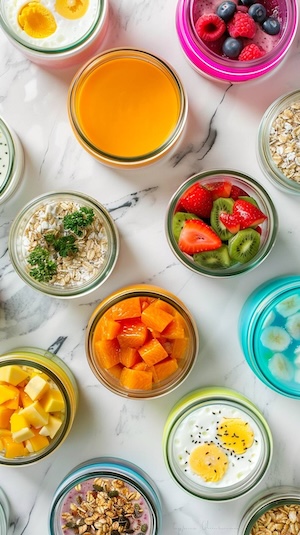PCOS for Picky Eaters: 30 Simple Meal Ideas
Discover 30 simple pcos meals for picky eaters that help manage symptoms. Easy pcos meals picky eaters will love, with practical tips and hormone-balancing ingredients.
This recipe includes superfoods such as:
Transform your health with tailored 7-day meal plans designed specifically for PCOS management. Just $7/month or $59/year.
Get it now →1/2 recipe Simple Pizza Dough, recipe follows
Olive oil, for brushing crust
8 ounces mozzarella, sliced
1/2 cup grated Parmesan, plus small chunk for shavingw
1 chicken breast, grilled and sliced thinly
2 romaine hearts, washed and dried, cut into 1/2-inch pieces
1/2 cup Caesar Salad Dressing, recipe follows
Kosher salt and freshly cracked black pepper
Prepare the Simple Pizza Dough according to recipe.
Preheat the oven to 500 degrees F.
On a baking sheet brushed liberally with olive oil, stretch the dough to desired shape and thickness. Brush the crust with olive oil and top with the mozzarella slices. Bake the pizza until the dough crisps up and cheese is melted, about 15 minutes.
Remove the pizza from oven. Top the melted mozzarella with the grated Parmesan and sliced chicken. Toss the romaine hearts with the Caesar Salad Dressing and season with salt and pepper. Top the pizza with the Caesar salad and shave over some Parmesan. Serve and enjoy!
Cook's Note: If you don't have a pizza stone at home, no worries, use a well-oiled sheet tray and a hot oven to achieve a crisp bottom on your pizza! Also place the dough on the very bottom rack of your oven. It will help to create that crispy crust.
In a blender or food processor, process the Parmesan, mayonnaise, lemon juice, olive oil, mustard, Worcestershire, salt, pepper, garlic and anchovy until emulsified and smooth. Refrigerate until ready to use.
In a liquid measuring cup, combine the warm water, yeast and sugar. Allow the yeast to dissolve and bloom, about 5 minutes. Once bloomed, add the olive oil.
Meanwhile, in the bowl of a stand mixer fitted with the paddle attachment, combine the flour and salt. Stream in the water/yeast mixture and as the dough begins to come together, switch to a dough hook attachment. Allow the dough to knead, adding a bit more flour if needed, so that the dough releases from the sides of the bowl, 1 to 3 minutes. You should be able to touch the dough and not have the dough stick to your fingers. Once the dough has kneaded and has pulled away from the sides of the bowl, remove the dough from bowl to a floured work surface and, with floured hands, continue to knead it by hand for 1 to 2 minutes. Then form the dough into a round ball and place it into a large bowl sprayed with nonstick spray. Cover the bowl with plastic wrap or a clean dish towel and let the dough rise in a warm area of your kitchen until it doubles in size, 1 1/2 to 2 hours. After the dough has risen it is ready to be cooked however you'd like!
Cook's Notes: This dough is wet dough, keep bench flour at the ready and make sure to flour your hands when working with the dough. Trust your gut as a chef, if the dough is to wet, add more flour, if it is too stiff, add a little water.
Sugar is used to feed the yeast which will help the dough to grow. Bread flour will give you a chewier texture because the flour has more gluten. You don't need to use a thermometer to get the water temperature, it should just feel warm to the touch.

You know the drill: Alarm goes off. You hit snooze. Rush around frantically. Skip breakfast AGAIN because there's no time. By 10am, you're hangry, your blood sugar is all over the place, and your PCOS symptoms are already acting up.
Sound familiar?
Finally – a meal prep system designed specifically for women with PCOS who refuse to let chaotic mornings derail their health goals.
In just ONE hour on Sunday, you can transform your entire week:
"I went from skipping breakfast 4 days a week to having delicious, hormone-supporting meals ready every morning. My energy is more stable and my cravings have disappeared!"
– Sarah M.
Stop letting chaotic mornings control your health.
Get your hormone-happy mornings starting this Sunday.
→ Get Your 60-Minute Solution Now
Transform your health with tailored 7-day meal plans designed specifically for PCOS management. Just $7/month or $59/year.
Get it now →Serving Size: 4
| Amount Per ONE Serving | ||
|---|---|---|
| Calories 0 kcal | ||
| Fat 0 g | ||
| Carbohydrate 0 g | ||
| Protein 0 g | ||
💡 Introducing the 10/10 PCOS Solution:
Ten Delicious Crockpot Recipes that take just 10 minutes to prep!
Say goodbye to hours in the kitchen and hello to clean, PCOS-friendly meals made effortlessly.
👉 Click here to grab your 10/10 PCOS Solution today! Try The 10/10 PCOS Solution: Ten Crockpot Recipes That Take Just Ten Minutes to Prep
Managing PCOS can be challenging, but you don't have to do it alone. Join our supportive community to connect with others who understand what you're going through, share tips, and get encouragement. Here's how you can get involved:
Subscribe to our Newsletter: Receive PCOS-friendly recipes, tips, research updates, and more delivered straight to your inbox. Stay informed and empowered with the latest information and support.
Join our Telegram Channel: Stay updated with the latest tips and advice on managing PCOS.
Follow PCOS Meal Planner on Facebook: Engage with our community, participate in discussions, and get support from others.
Break the cycle with the PCOS Meal Planner - your personalized guide to eating better, feeling better, and managing PCOS symptoms. Take control today!

Forget the frustrating cycle of weight loss attempts, endless medications, and living in discomfort. Introducing the PCOS Meal Planner. A meal planning guide that goes beyond temporary fixes to offer a comprehensive strategy, empowering you to ignite a transformation towards lasting health and happiness. Step into a world where you control your PCOS, not the other way around.
Unlock Your PCOS Freedom Now.
Discover 30 simple pcos meals for picky eaters that help manage symptoms. Easy pcos meals picky eaters will love, with practical tips and hormone-balancing ingredients.
Discover 15 delicious overnight oats for PCOS recipes that help balance hormones and manage symptoms. Easy, nutritious breakfast ideas perfect for women with PCOS.
Discover the best cereal for PCOS with our expert rankings. Compare brands, check ingredients, and find PCOS friendly cereal that supports hormonal balance.
Learn how to transition away from fruit when starting a ketogenic diet for PCOS. Discover gradual strategies, fruit alternatives, and practical tips for success.
Discover 5 delicious PCOS banana bread recipes with low-glycemic ingredients. Learn how to make hormone-friendly banana bread that supports blood sugar balance.
Creatine for women with PCOS explained simply. Learn safety, benefits, hormone effects, tips, and how creatine may support PCOS symptoms naturally.
Complete PCOS diet plan with foods to eat, foods to avoid, meal timing, and real results. Learn the science-backed approach to managing PCOS through diet, with 7-day meal plan, grocery list, and step-by-step implementation guide. Based on clinical research and real patient outcomes.
Complete guide to ordering at Wendy's with PCOS. Discover the best protein-focused meals, what to skip, and how to customize orders to keep blood sugar stable. Learn which burgers, salads, and sides work for PCOS, plus complete macros for every menu item and smart swaps to avoid insulin spikes.
Complete guide to ordering at Burger King with PCOS. Discover the best protein-focused meals, what to skip, and how to customize orders to keep blood sugar stable. Learn which burgers, salads, and sides work for PCOS, plus complete macros for every menu item and smart swaps to avoid insulin spikes.